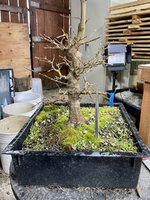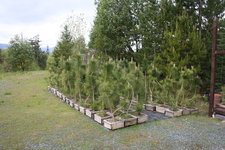parhamr
Omono
I’m working on an upright Trident Maple. It’s one of many trees where I’m attempting a fairly conventional and traditional aesthetic to build some of my skills. I’ll update this thread over time with progress.
I got the tree in 2014 as a $14 sapling with a pencil-thin trunk in a 4" pot. I moved it into a 14" wide mica pot. This was before I joined BSOP and had access to better material.
I’m growing it out and trying to produce taper and girth by letting the tree grow 6–8 feet tall each season. I’ve been trying to keep the lower, inner branches viable and ready for refinement through careful pruning
Here’s the earliest photo I have, from April 2015:

December 2015:

April 2017: (moved into a 21" square grow box of 3.5" depth)

November 2018: (it’s the tallest tree, red colored leaves)

March 2019: at a BSOP repotting demo (the box was entirely filled with roots!)

Now… (in a 15" Anderson flat)

The trunk is thickening nicely:

The 2017 chop site is fully closed with new tissue:

This year’s leader is thick and the stub from the latest trunk chop is ready to be trimmed flush this winter:

So that’s where I’m at right now. This is a work in progress and I’m in it for the journey. In upcoming years I might end up doing some grafts or layer the tree to improve the nebari.
I got the tree in 2014 as a $14 sapling with a pencil-thin trunk in a 4" pot. I moved it into a 14" wide mica pot. This was before I joined BSOP and had access to better material.
I’m growing it out and trying to produce taper and girth by letting the tree grow 6–8 feet tall each season. I’ve been trying to keep the lower, inner branches viable and ready for refinement through careful pruning
Here’s the earliest photo I have, from April 2015:

December 2015:

April 2017: (moved into a 21" square grow box of 3.5" depth)

November 2018: (it’s the tallest tree, red colored leaves)

March 2019: at a BSOP repotting demo (the box was entirely filled with roots!)

Now… (in a 15" Anderson flat)

The trunk is thickening nicely:

The 2017 chop site is fully closed with new tissue:

This year’s leader is thick and the stub from the latest trunk chop is ready to be trimmed flush this winter:

So that’s where I’m at right now. This is a work in progress and I’m in it for the journey. In upcoming years I might end up doing some grafts or layer the tree to improve the nebari.
Last edited:















